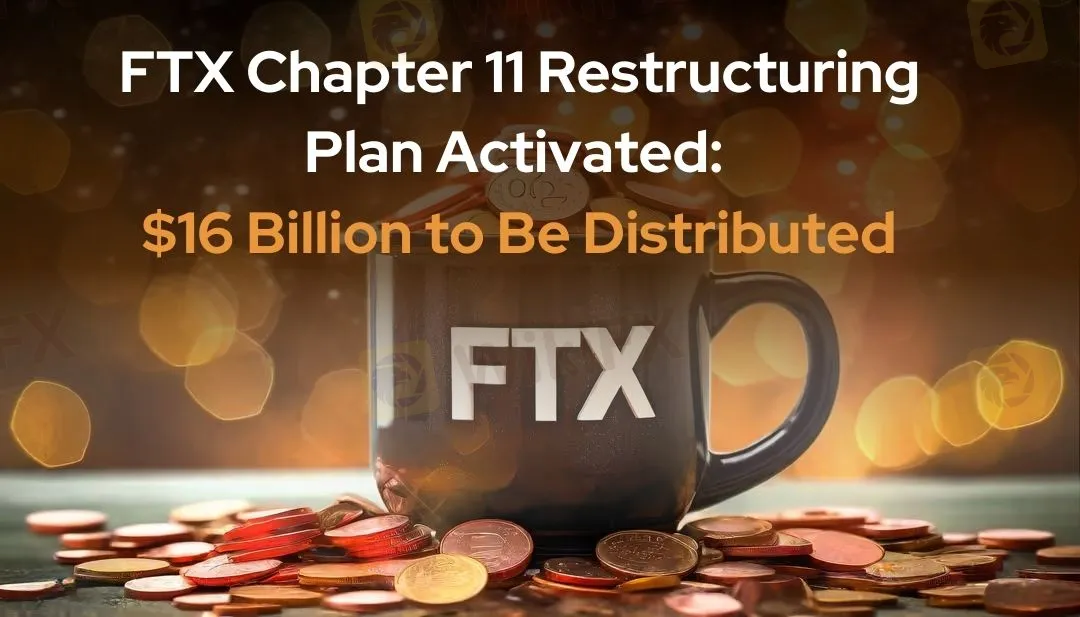简体中文
繁體中文
English
Pусский
日本語
ภาษาไทย
Tiếng Việt
Bahasa Indonesia
Español
हिन्दी
Filippiiniläinen
Français
Deutsch
Português
Türkçe
한국어
العربية
FTX Chapter 11 Restructuring Plan Activated: $16 Billion to Be Distributed
Abstract:The highly anticipated FTX Chapter 11 bankruptcy restructuring plan officially comes into effect today, marking a critical step forward for the cryptocurrency exchange in recovering from its collapse. A $16 billion recovery fund begins distribution today, offering hope to creditors worldwide.

The court previously approved FTX‘s Chapter 11 restructuring plan to take effect on January 3, 2025, with today set as the record date for the initial distribution. BitGo and Kraken have been designated as FTX’s distribution partners to assist customers and creditors in reclaiming funds. Users are required to complete tasks such as KYC verification, tax form submission, and coordination with designated service providers. Claimants must promptly fulfill these requirements to ensure a smooth distribution process. The first distributions are expected to be completed within 60 days of the effective date.
From Peak to Bankruptcy: FTXs Rapid Fall
Once one of the worlds leading cryptocurrency exchanges, FTX was valued at $32 billion at its peak. However, in November 2022, the exchange filed for bankruptcy protection within days after suffering massive losses due to the misuse of customer funds for high-risk investments. This led to a two-year-long bankruptcy restructuring process aimed at liquidating assets and repaying creditors.
FTX‘s collapse triggered a ripple effect in the cryptocurrency market, causing significant price declines in major cryptocurrencies like Bitcoin and eroding market confidence. Investors began questioning the security and regulatory compliance of cryptocurrency exchanges, prompting other exchanges to enhance transparency and compliance measures. Furthermore, FTX’s downfall highlighted systemic risks in the cryptocurrency industry, prompting regulators to increase scrutiny of the sector.
FTX Distributions Begin: Reshaping the Crypto Industry
The FTX claims distribution plan officially takes effect today (January 3, 2025), initiating the allocation of $16 billion in assets globally. This presents significant challenges in ensuring fair and efficient distribution while addressing the complex demands of creditors.
Notably, the reintroduction of large sums of money into the market could cause short-term volatility in certain crypto assets, exacerbating market instability. However, this bankruptcy restructuring is not just a resolution of the FTX crisis; it also sets a vital precedent for handling large-scale insolvencies in the crypto industry, providing valuable lessons for future cases.
As the distribution plan progresses, the industry may see stricter regulatory frameworks and increased transparency requirements. These changes could help standardize market practices, restore investor confidence, and drive the crypto industry toward healthier and more sustainable growth.
Disclaimer:
The views in this article only represent the author's personal views, and do not constitute investment advice on this platform. This platform does not guarantee the accuracy, completeness and timeliness of the information in the article, and will not be liable for any loss caused by the use of or reliance on the information in the article.
Read more

What Are The Top 5 Cryptocurrency Predictions For 2025?
Discover the top 5 cryptocurrency predictions for 2025, including Ethereum's rise, a potential bear market, meme coin struggles, and regulatory shifts.

Stablecoins: The New Frontier in Digital Finance?
In 2024, while Bitcoin’s surge past US$100,000 captured global attention, financial institutions turned their focus to stablecoins. Will stablecoins be the new frontier in digital finance for the year of 2025?

Top 9 Financial Fraud Cases in Recent History
Know the top 9 financial fraud cases in history, from Enron to FTX, uncovering deception and greed. Learn how WikiFX protects investors from scams and fraud.

KuCoin Pay Introduces Easy Crypto Payments for Merchants
How KuCoin Pay, an innovative PoS system enabling merchants to accept 54 cryptocurrencies, including Bitcoin, Ethereum, and USDT, for seamless transactions.
WikiFX Broker
Latest News
PH SEC Issues Crypto Guidelines for Crypto-Asset Service Providers
FTX Chapter 11 Restructuring Plan Activated: $16 Billion to Be Distributed
Think Before You Click: Malaysian Loses RM240,000 to Investment Scam
Share Industry Insights and Discuss Forex Market Trends
Top 9 Financial Fraud Cases in Recent History
KuCoin Pay Introduces Easy Crypto Payments for Merchants
Malaysian Man Killed in Alleged Forex Dispute-Related Attack
How Big is the Impact of the USD-JPY Rate Gap on the Yen?
What Euro Investors Can't Afford to Miss
Is OneRoyal the Right Broker for You?
Currency Calculator






